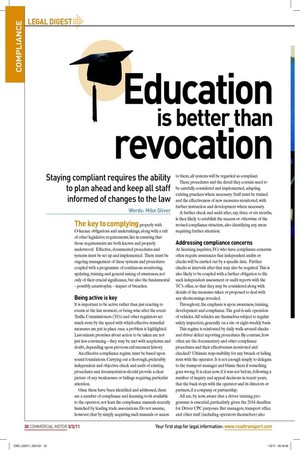Education
Page 23

Page 24

If you've noticed an error in this article please click here to report it so we can fix it.
is better than
revocation
Staying compliant requires the ability to plan ahead and keep all staff informed of changes to the law
Words: Mike Oliver
The key to complying properly with O-licence obligations and undertakings, along with a raft of other legislative requirements, lies in ensuring that those requirements are both known and properly understood. Effective, documented procedures and systems must be set up and implemented. There must be ongoing management of these systems and procedures coupled with a programme of continuous monitoring, updating, training and general raising of awareness, not only of their crucial signiicance, but also the fundamental – possibly catastrophic – impact of breaches.
Being active is key
It is important to be active rather than just reacting to events at the last moment, or being wise after the event. Trafic Commissioners (TCs) and other regulators set much store by the speed with which effective remedial measures are put in place once a problem is highlighted. Last-minute promises about action to be taken are not just less convincing – they may be met with scepticism and doubt, depending upon previous enforcement history.
An effective compliance regime must be based upon sound foundations. Carrying out a thorough, preferably independent and objective check and audit of existing procedures and documentation should provide a clear picture of any weaknesses or failings requiring particular attention.
Once these have been identiied and addressed, there are a number of compliance and licensing tools available to the operator, not least the compliance manuals recently launched by leading trade associations. Do not assume, however, that by simply acquiring such manuals or access to them, all systems will be regarded as compliant.
These procedures and the detail they contain need to be carefully considered and implemented, adapting existing practices where necessary. Staff must be trained and the effectiveness of new measures monitored, with further instruction and development where necessary.
A further check and audit after, say, three or six months, is then likely to establish the success or otherwise of the revised compliance structure, also identifying any areas requiring further attention.
Addressing compliance concerns
At licensing inquiries, TCs who have compliance concerns often require assurances that independent audits or checks will be carried out by a speciic date. Further checks at intervals after that may also be required. This is also likely to be coupled with a further obligation to ile such independent assessment or audit reports with the TC’s ofice, so that they may be considered along with details of the measures taken or proposed to deal with any shortcomings revealed.
Throughout, the emphasis is upon awareness, training, development and compliance. The goal is safe operation of vehicles. All vehicles are themselves subject to regular safety inspection, generally on a sixor eight-weekly basis.
This regime is reinforced by daily walk-around checks and driver defect reporting procedures. By contrast, how often are the documentary and other compliance procedures and their effectiveness monitored and checked? Ultimate responsibility for any breach or failing rests with the operator. It is not enough simply to delegate to the transport manager and blame them if something goes wrong. It is clear now, if it was not before, following a number of inquiry and appeal decisions in recent years, that the buck stops with the operator and its directors or partners, if a company or partnership.
All are, by now, aware that a driver training programme is essential, particularly given the 2014 deadline for Driver CPC purposes. But managers, transport ofice and other staff (including operators themselves) also need heightened awareness and proper understanding of both licensing and other compliance provisions.
This will assist in gaining a fuller appreciation of the signiicance and importance of their individual roles within the operation. Membership of trade associations, attendance at seminars offered by TCs or VOSA, reading the trade press and taking proper advice, all assist in keeping up with, if not ahead of, the game.
Prepare for change
More changes are coming. Towards the end of this year, limits will come into force covering the leet size and number of operations an independently contracted CPC holder may manage. While aimed at small-to-medium operations, it remains to be seen whether any wider implications may arise from these restrictions.
Operator licensing across Europe is to move towards greater standardisation. More detailed information about operators who have committed serious offences is to be shared internationally through an interlinked series of databases. All of this reinforces the need for implementation of effective compliance procedures, ongoing monitoring, training and education, along with a readiness to meet the demands of changes and developments.
A programme of continuous monitoring and checking on a structured basis is an essential step on the road to effective compliance. Education is preferable to revocation. ■
● Mike Oliver is a transport consultant at national law irm Berrymans Lace Mawer LLP www.blm-law.com



















































